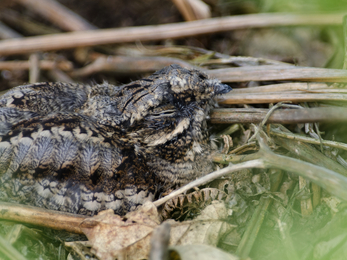Nightjar
The nocturnal nightjar is one of our strangest birds. A wide-mouthed, insect-eating summer visitor to heathlands and young conifer plantations, they spend their days sitting on the floor, where they also nest. Cryptically camouflaged in greys and browns, they look just like a fallen log and are almost impossible to spot during the day. But at dusk, a strange sound starts up: a mechanical whirring, almost like a distant engine, and just as the darkness arrives, the nightjar appears.
Experience the eerie mechanical call and wing-slapping display of the nightjar in heaths and woodland clearings
Find nightjars near you
Chobham Common in Surrey is home to a flourishing population of nightjars. Make sure you come for the day, as there’s a lot to see on this, the largest National Nature Reserve in south east England and one of the finest lowland heaths in the world.
- Berkshire, Greenham and Crookham Commons
- Berkshire, Wildmoor Heath
- Conwy, Cors Bodgynydd
- Devon, Bovey Heathland,
- Devon, Bystock Pools,
- Devon, Chudleigh Knighton Heath
- Dorset, Higher Hyde Heath,
- Dorset, Tadnoll and Winfrith
- Gwynedd, Gwaith Powdwr
- Norfolk, Roydon Common and Grimston Warren
- Suffolk, Blaxhall Common,
- Suffolk, Sutton and Hollesley Commons
- Surrey, Chobham Common,
- Surrey, Ockham and Wisley Commons
How to do it
From April and May, nightjars nest on the ground on heathland and in young conifer woods. Arrive before dusk, and find a good spot on the heath with as wide a view as possible, preferably with open skies: it’s a lot easier to spot the birds in silhouette than amongst the dark trees. As darkness falls, the nightjar appears: almost falcon like in shape, with a silhouette of long stiff wings and a long tail, a jerky flight across the sky. Listen out for the odd churring song and occasional claps of wings: a male nightjar, displaying to attract the nearby females.
As with all ground nesting birds, stay on the footpath and leave the dog at home.
If you can't get to these places
Night time can be a great time to be out in the woods. Listen for owls hooting, foxes screaming, maybe a badger blundering through the undergrowth. You may be surprised at how many birds wake up for a short song half way through the night. If you want to hear the distinctive churring of the nightjar, check out some great film clips on the BBC website.
More wildlife experiences
From seeing colourful wildflowers to spotting magnificent birds of prey, we can help you get closer to wildlife across the UK.








